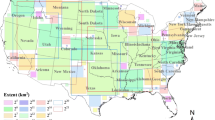Abstract
Research performed on microlandscapes embodies the essence of landscape ecology by focusing on the ecological consequences of the mosaic structure of different landscape elements. As an illustration, observations and simulations were used to test whether the fractal structure of grassland microlandscapes affected the movement patterns of tenebrionid beeetles in natural environments. The significant tendency of beetles to avoid 1 m2 cells with fractal dimensions of 1.85 to 1.89 (indicating the area-filling tendency of bare ground) demonstrated the role of landscape structure as a modifier of beetle movements or diffusion in heterogeneous landscapes. Experiments in microlandscapes may accelerate the development of quantitative conceptual frameworks applicable to landscapes at all scales.
Similar content being viewed by others
References
Addicott, J.F., Aho, J.M., Antolin, M.F., Padilla, D.K., Richardson, J.S. and Soluk, D.A. 1987. Ecological neighborhoods: scaling environmental patterns. Oikos 49: 340–346.
Calkins, C.O. and Kirk, V.M. 1973. Distribution and movement of adult false wireworms in a wheat field. Ann. Entomol. Soc. Am. 66: 527–532.
Crawford, C.S. 1981. Biology of Desert Invertebrates. Springer-Verlag, New York.
Davis, J.C. 1986. Statistics and Data Analysis in Geology, 2nd ed. John Wiley & Sons, New York.
De Cola, L. 1989. Fractal analysis of a classified Landsat scene. Photogrammetric Engineering and Remote Sensing 55: 601–610.
Doyen, J.T. and Tschinkel, J.T. 1974. Population size, microgrographic distribution and habitat separation in some tenebrionidae beetles (Coleoptera). Ann. Entomol. Soc. Am. 67: 617–626.
Fahrig, L., Lefkovitch, L. and Merriam, G. 1983. Population stability in a patchy environment. In Analysis of Ecological Systems: State-of-the-art in Ecological Modeling, pp. 61–67. Edited by W.K. Lauenroth, G.V. Skogerboe and M.Flug. Elsevier, New York.
Forman, R.T.T. and Godron, M. 1986. Landscape Ecology. John Wiley & Sons, New York.
Gardner, R.H., Milne, B.T., Turner, M.G. and O'Neill, R.V. 1987. Neutral models for the analysis of broad-scale landscape pattern. Landsc. Ecol. 1: 19–28.
Kareiva, P.M. 1985. Finding and losing host plants by Phyllotreta: patch size and surrounding habitat. Ecology 66: 1809–1816.
Kareiva, P.M. and Shigesada, N. 1983. Analyzing insect movement as a correlated random walk. Oecologia 56: 234–238.
Kramm, R.A. and Kramm, K.P. 1972. Activities of certain species of Eleodes in relation to season, temperature, and time of day at Joshua Tree National Monument (Coleoptera: Tenebrionidae). Southw. Natur. 16: 341–355.
Krummel, J.R., Gardner, R.H., Sugihara, G., O'Neill, R.V. and Coleman, P.R. 1987. Landscape patterns in a disturbed environment. Oikos 48: 321–324.
Mandelbrot, B. 1983. The Fractal Geometry of Nature. W.H. Freeman and Co., New York.
Milne, B.T. (in press). Lessons from the application of fractals in landscape ecology. In Quantitative Methods in Landscape Ecology. Edited by M.G. Turner and R. Gardner. Springer-Verlag, New York.
Milne, B.T. 1988. Measuring the fractal geometry of landscapes. Appl. Mathem. Comput. 27: 67–79.
Milne, B.T. 1989. Heterogeneity as a multi-scale characteristic of landscapes. In Ecological Heterogeneity. Edited by J. Kolasa and S.T.A. Pickett. Springer-Verlag, New York.
Milne, B.T., Johnston, K.M. and Forman, R.T.T. 1989. Scale-dependent proximity of wildlife habitat in a spatially-neutral Bayesian model. Landsc. Ecol. 2: 101–110.
Naveh, Z. 1982. Landscape ecology as an emerging branch of human ecosystem science. Adv. Ecol. Res. 12: 189–237.
Naveh, Z. and Lieberman, A.S. 1984. Landscape Ecology. Theory and Application. Springer-Verlag, New York.
Orbach, R. 1986. Dynamics of fractal networks. Science 231: 814–819.
Palmer, M.W. 1988. Fractal geometry: a tool for describing spatial patterns of plant communities. Vegetatio 75: 91–102.
Peitgen, H.-O. and Saupe, D. (eds.) 1988. The Science of Fractal Images. Springer-Verlag, New York.
Risser, P.G., Karr, J.R. and Forman, R.T.T. 1984. Landscape ecology: directions and approaches. Illinois Nat. Hist. Surv. Spec. Publ., 2: 1–18.
Senft, R.L., Coughenour, M.B., Bailey, D.W., Rittenhouse, L.R., Sala, O.E. and Swift, D.M. 1987. Large herbivore foraging and ecological hierarchies. BioScience 37: 789–799.
Sokal, R.R. and Rohlf, F.J. 1969. Biometry. W.H. Freeman and Co., San Francisco.
Stauffer, D. 1985. Introduction to Percolation Theory. Taylor and Francis Publishers, London.
Swihart, R.K., Slade, N.A. and Bergstrom, B.J. 1988. Relating body size to the rate of home range use in mammals. Ecology 69: 393–399.
Taub, F.B. 1974. Closed ecological systems. Ann. Rev. Ecol. Syst. 5: 139–160.
Troll, C. 1968. Landschaftsökologie. In Pflanzensoziologie und Landschaftsökologie, pp. 1–21. Edited by R. Tüxen. Dr W. Junk Publishers, The Hague.
Voss, R.F. and Clarke, J. 1975. ‘1/f noise’ in music and speech. Nature 258: 317–318.
Wiens, J.A. (in press). Spatial scaling in ecology. Functional Ecology.
Wiens, J.A., Addicott, J.F., Case, T.J. and Diamond, J. 1986. Overview: the importance of spatial and temporal scale in ecological investigations. In Community Ecology, pp. 145–153. Edited by J. Diamond and T.J. Case. Harper & Row, New York.
Wiens, J.A., Crawford, C.S. and J.R. Gosz. 1985. Boundary dynamics: a conceptual framework for studying landscape ecosystems. Oikos 45: 421–427.
Wiens, J.A., Rotenberry, J.T. and Van Horne, B. 1987. Habitat occupancy patterns of North American shrubsteppe birds: the effects of spatial scale. Oikos 48: 132–147.
Zonneveld, I.S. 1979. Land Evaluation and Land(scape) Science. International Training Center, Enschede, The Netherlands.
Author information
Authors and Affiliations
Rights and permissions
About this article
Cite this article
Wiens, J.A., Milne, B.T. Scaling of ‘landscapes’ in landscape ecology, or, landscape ecology from a beetle's perspective. Landscape Ecol 3, 87–96 (1989). https://doi.org/10.1007/BF00131172
Issue Date:
DOI: https://doi.org/10.1007/BF00131172




